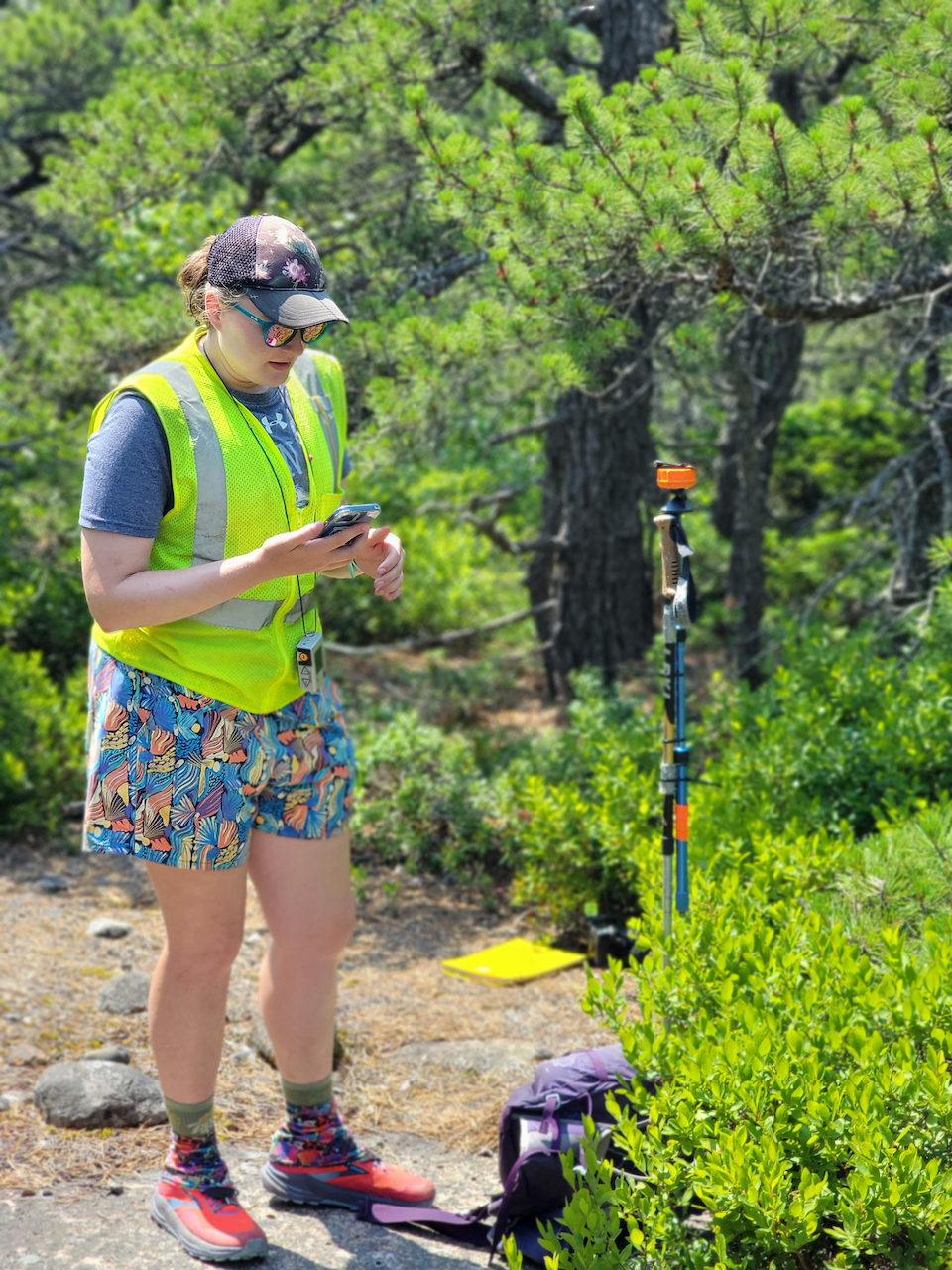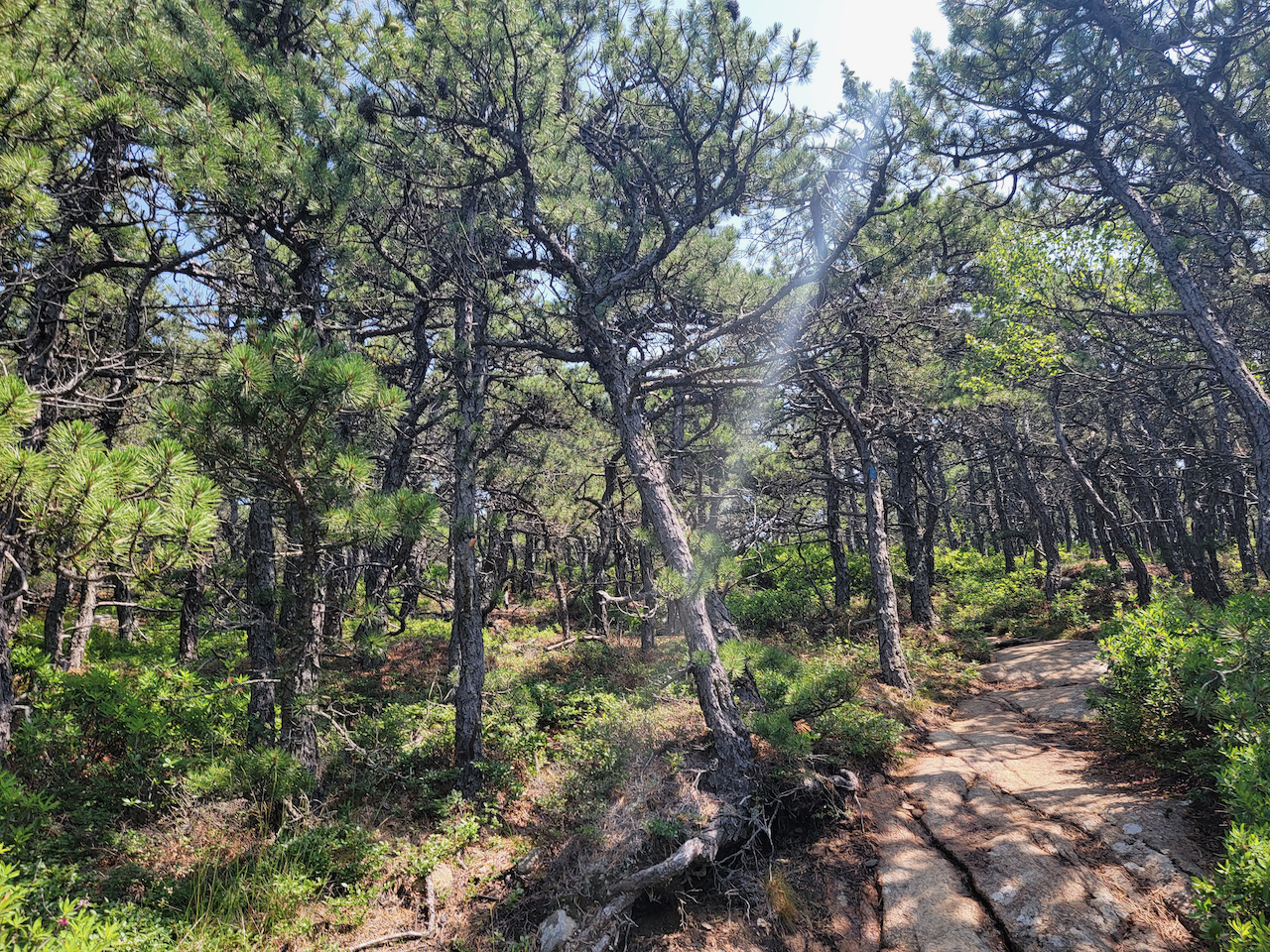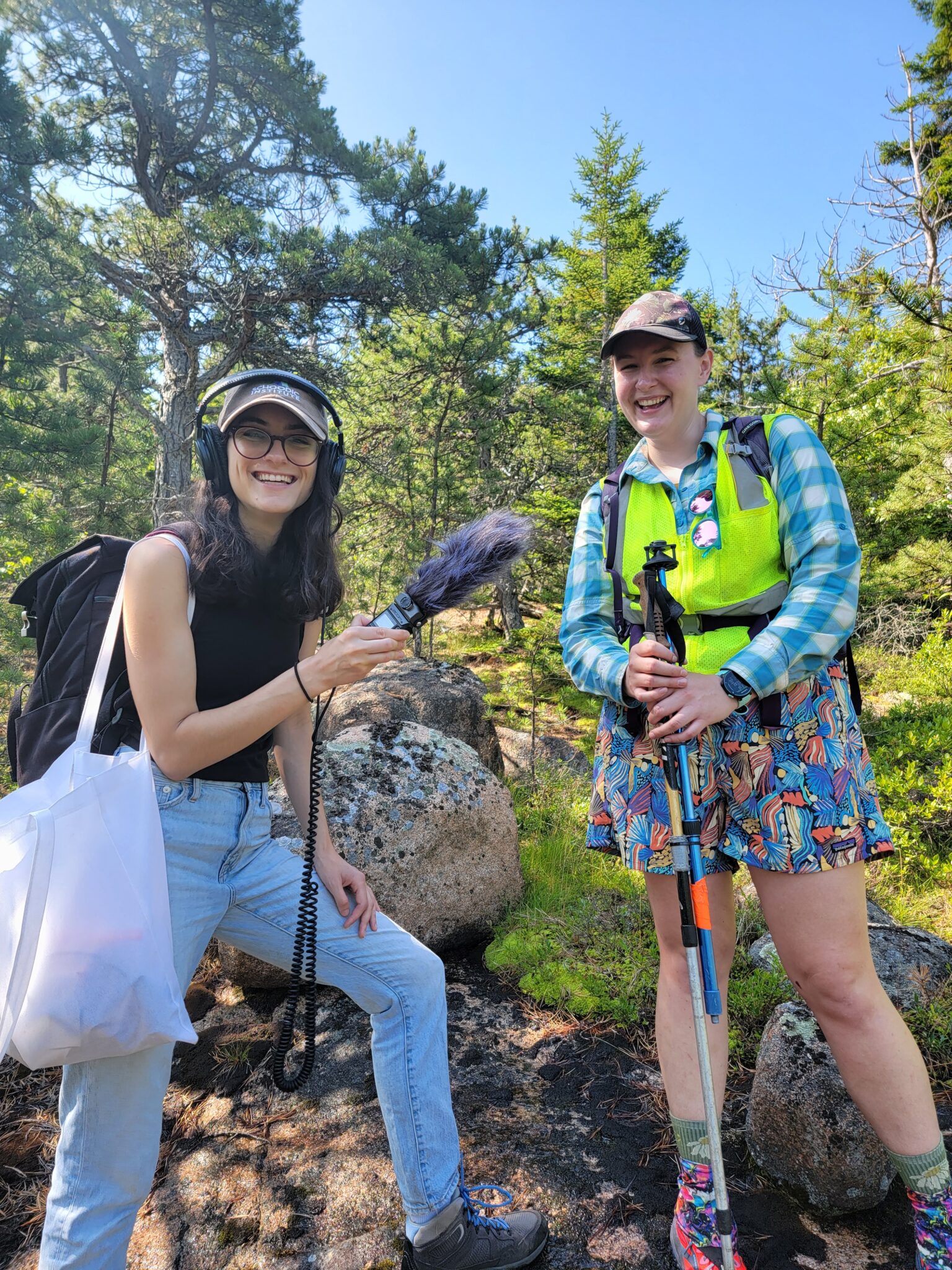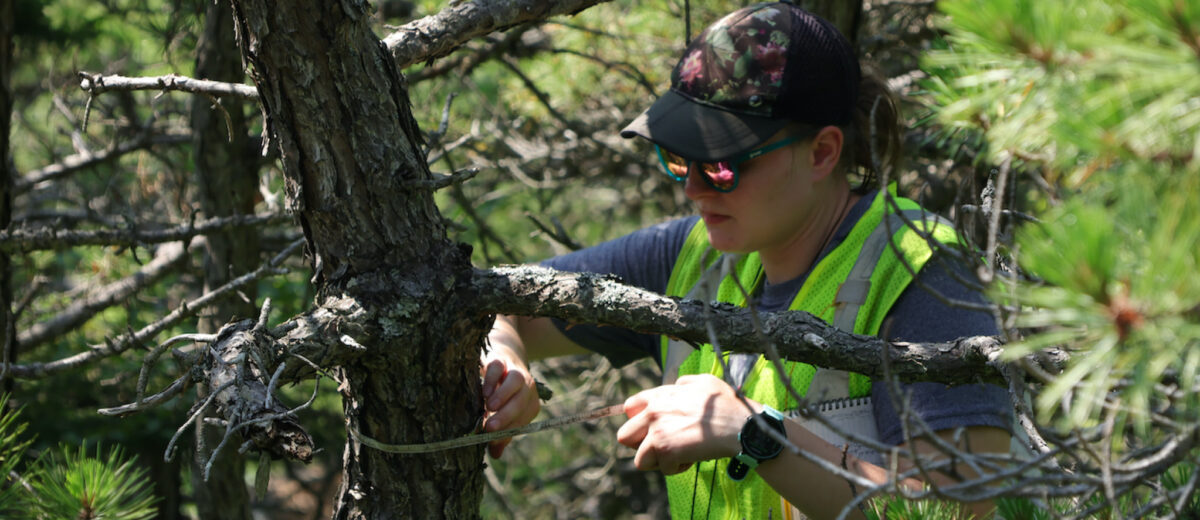by Catherine Devine, photos by Catherine Schmitt
 Caroline Kanaskie hiked up Dorr Mountain with an even gate. It was clear she’d been here before. Her strides were long and purposeful, her speech brimming with excitement as she recalled her last week at Schoodic Institute in Winter Harbor, Maine, where she was a recipient of a Second Century Stewardship Fellowship.
Caroline Kanaskie hiked up Dorr Mountain with an even gate. It was clear she’d been here before. Her strides were long and purposeful, her speech brimming with excitement as she recalled her last week at Schoodic Institute in Winter Harbor, Maine, where she was a recipient of a Second Century Stewardship Fellowship.
“Over here is my next point,” she said, before veering off trail through brumple and brush until we reached a circular clearing with an exposed path of smooth granite. She placed her bags on the patch of bald and began unpacking, pulling out all sorts of equipment that looked strange to my non-ecologist eyes.
She held up a rectangular prism, small and clear. “This” she emphasized, “is how I’m going to know what trees I’m going to survey.”
I looked at her perplexed. What sort of magic prism is this? I thought. She motioned for me to glance through the prism, holding it close to my right eye. When I looked through the shape, the tree looked disjointed. “That’s how you know the tree is too far away,” she said. I pointed the prism at a closer tree, and the image appeared unchanged — this tree was in Caroline’s range.
The prism, also known as a survey prism or optical angle gauge, enabled Caroline to map out the boundaries of her plot simply by glancing through it. The prism uses light refraction to signal the prism user’s distance from the object they are looking at — only the trees within Caroline’s boundary would appear whole in the shape’s reflection.
The tree was a pitch pine, and she observed it with all the thoroughness you’d expect from a researcher who’s been studying pitch pines for years. A wiry, twisted looking tree, pitch pine is abundant in Acadia National Park. The trees, named after use of the tree sap to create turpentine and pitch to coat wooden ships as a preservative, also historically provided paper pulp, lumber, and “fatwood” kindling for fire starting. Growing throughout the eastern United States and Canada, pitch pines compose a significant portion of forests in the eastern United States from backyard to summit.
***
Back in 2021, Caroline made a shocking discovery. She was a Ph.D. student at the University of New Hampshire studying the southern pine beetle.
When she started her Ph.D. in 2019, Caroline hoped to study the farthest-north southern pine beetle infestations, which were at that time on Long Island, New York. But due to COVID restrictions, she had to change plans and keep her research within a few hour radius of her University. There were no southern pine beetles in her new radius, so she designed a study to survey the existing forest insects in places where southern pine beetles might one day be. One day, Caroline was collecting insects from a trap in Waterboro, Maine, and she did a double take.
She looked at her sample under a microscope, but it just didn’t make any sense. “It looked like a southern pine beetle,” she recalled. “I was like, whoa, they’ve never been here before. That we know of. And I was second guessing myself.” She sent her sample off to another entomologist for confirmation… and confirmed it was.
“And it was very surprising. In entomology, that’s what we would call a new record or a new finding,” she said.
***
 The beetles crawl inside the bark of pitch pine trees where they feast on the sugary, fibrous layer and lay eggs, slowly killing the tree from the inside out. When the beetles exist in low numbers they are extremely hard to locate; it’s only when there’s an infestation that their presence becomes clear. Unfortunately, by that stage there isn’t much forest managers can do to save the fate of the trees.
The beetles crawl inside the bark of pitch pine trees where they feast on the sugary, fibrous layer and lay eggs, slowly killing the tree from the inside out. When the beetles exist in low numbers they are extremely hard to locate; it’s only when there’s an infestation that their presence becomes clear. Unfortunately, by that stage there isn’t much forest managers can do to save the fate of the trees.
Southern pine beetle populations, native to the southeastern United States, have slowly been crawling up the northeastern coast, posing new threats to the northernmost pitch pines.
Caroline’s research is all about assessing the risk that the beetle poses to Acadia National Park. The key factors are temperature on the coldest night of the year, pitch pine volume and density: if it is warm enough for beetles to survive the coldest moments of winter, then the denser the trees and the greater the percentage of pitch pine trees, the higher the risk. Caroline spent the field work days of her fellowship hiking to randomly generated coordinates and collecting data on pitch pine volume and density. “It’s kind of like how much food is in the fridge for us?” Caroline explained. “How many trees are in an area that the beetle could attack in one day.”
What’s unique about Caroline’s study is that it’s proactive. The southern pine beetle isn’t tearing through Acadia yet, but her data will allow the park to develop a plan for the day it likely does. Her analysis will determine how data from her sampling points can be applied to the whole park and allow park managers to develop a plan of action in preparation for if and when the beetle arrives.
“We always love to see more information over a period of time that can help us make decisions,” said Jesse Wheeler, Vegetation Program Manager for Acadia National Park. “The more information that we have over decades, the better.”
“Although it’s not an imminent threat, to be able to do this kind of sampling and inventory now, instead of later, when the beetle is more of a threat,” Caroline said, “I think it’ll give us valuable information to be able to make decisions about what to do when the beetle gets closer.”
***
Caroline rummaged through her pack until she pulled out a bright orange piece of equipment, round and plastic – like a smoke detector. She fastened it to a tripod and staked it hard into the soft ground between the granite. She grabbed a handheld device, and walked from the tripod to a tree until she heard a gentle click. The devices “talked” to each other via ultrasound waves, recording the distance between them. This would allow her to determine the density of the pitch pine trees in her plot by allowing her to measure the spread of the trees.
“And to close it off,” she said, “I’m going to use my DBH tape.” The acronym stands for diameter at breast height, the forest industry standard for measuring tree diameter at 4.5 feet above the ground. She hugged the tree with her tape, noting the measurement in her notebook. Only trees with a large enough diameter will be included in the study.
These measurements, along with a count of the trees in the plot, are all Caroline needs to gather the data necessary for forest managers to best prepare an action plan for the southern pine beetle’s arrival.
***
As it stands, the higher risk areas Caroline identifies could be good spots for monitoring the beetle. These areas could also be candidates for forest management activities, like thinning (the process of cutting down rows of trees in an area) in order to lower the risk of a southern pine beetle outbreak.
“What Caroline learns will be informative for the greater field of study, and also very useful for us locally here when the time comes,” Wheeler reflected.
***
I looked around at my surroundings. The sun reflected off the granite, hugging me with its warm rays. The pitch pine trees around me stood tall and firm. I thought about the southern pine beetles crawling up the northeastern coast towards me, towards Acadia, towards the park’s trees. I felt helpless. Waiting for the beetles to come, maybe years from now, maybe more.
When it comes to conservation, action is often reactive rather than proactive. Competing priorities, constrained budgets, and exponentially increasing threats all play a role. The proactive nature of Caroline’s study gives me hope. In the battle to protect the life of these pitch pines, her data will give park managers the best chance of caring for the future of these trees. Data over decades – that is something to celebrate, even though I wish it was unremarkable.

